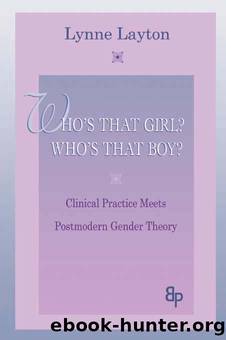Who's That Girl? Who's That Boy? by Layton Lynne;

Author:Layton, Lynne;
Language: eng
Format: epub
ISBN: 1433887
Publisher: Taylor & Francis Group
* This chapter is adapted from Layton 1995 (copyright © 1995 by Johns Hopkins University Press and used by permission).
1Kaplan (1987, 1993) and Penley (1992) would fall under Ebertâs âludic feminismâ rubric (she also includes Donna Haraway and Jane Gallop). Ellen Friedman (1993), who associates fragmentation with women writersâ refusal to constitute an identity in accord with patriarchy, is not a ludic feminist; I include her because her essay evaluates fragmented style as a strategy of resistance and shows little regard for the social and personal roots of the painful state of fragmentation that produces such a style, a style that reveals as much oppression as resistance. As I have noted several times in this book, Butlerâs work is so multiple itself that it is hard to categorize. But I would say that parts of Gender Trouble (Butler 1990a) are ludic, in that power inequalities between men and women are not addressed (in Chapter 9 I shall try to untangle some of Butlerâs theoretical shifts).
I cite Ebert because the celebration of fragmentation and the celebration of diversity (internal and external), while not the same thing, stand in relation to one another, as the ensuing discussion will demonstrate.
2Ebert focuses on pleasure as central to the âludic feminismâ she critiques; the heart of her criticism is the suggestion that only a class that does not have to worry about the body as a source of labor could so focus on the body as primarily a source of pleasure. Here I am arguing that this focus on pleasure entails not a safe haven from pain but a denial of it. That is, I assume that even the class position from which the ludic feminists speak must be marked by its own dialectic of pleasure and pain; for this reason, the omission of pain or labor is not just a sign of privilege but is in some way defensive.
3I am here extending to the experiential psychological level Amanda Andersonâs political/ethical argument in âCryptonormativism and Double Gesturesâ (1992). Anderson argues that, to maintain a feminist politics, postmodern political theorists have had to perform a double gesture, that is, to allow for essentialism or identity politics in practice while asserting what they consider to be a superior antifoundationalism and antihumanism in theory. Anderson presents an intersubjective ethical theory (based on Habermas) in which subjects are constituted not by dominating systems but by ongoing relations with others. In this view, the systemic informs intersubjective relations but does not define them, and domination is no more endemic to communication than is mutual respect. What I want to suggest here is that the same is true on the intrapsychic level. See Chapter 2 for my discussion of the relation between narcissistic and non-narcissistic constituents of the self.
4Butler (1992) argues that there is no necessary contradiction between the assumption of a socially constructed subject and the experience of agency: âWe may be tempted to think that to assume the subject in advance is necessary in order to safeguard the agency of the subject.
Download
This site does not store any files on its server. We only index and link to content provided by other sites. Please contact the content providers to delete copyright contents if any and email us, we'll remove relevant links or contents immediately.
The Art of Thinking Clearly by Rolf Dobelli(8881)
The 5 Love Languages: The Secret to Love That Lasts by Gary Chapman(8551)
Mindhunter: Inside the FBI's Elite Serial Crime Unit by John E. Douglas & Mark Olshaker(7860)
Becoming Supernatural by Dr. Joe Dispenza(7130)
The Road Less Traveled by M. Scott Peck(6660)
Nudge - Improving Decisions about Health, Wealth, and Happiness by Thaler Sunstein(6651)
Enlightenment Now: The Case for Reason, Science, Humanism, and Progress by Steven Pinker(6423)
Win Bigly by Scott Adams(6334)
Mastermind: How to Think Like Sherlock Holmes by Maria Konnikova(6264)
The Way of Zen by Alan W. Watts(5818)
Factfulness: Ten Reasons We're Wrong About the World – and Why Things Are Better Than You Think by Hans Rosling(4035)
The State of Affairs by Esther Perel(3955)
Gerald's Game by Stephen King(3937)
Man's Search for Meaning by Viktor Frankl(3661)
The Confidence Code by Katty Kay(3580)
Thinking in Bets by Annie Duke(3545)
The Worm at the Core by Sheldon Solomon(2936)
Enlightenment Now by Steven Pinker(2927)
Liar's Poker by Michael Lewis(2824)
